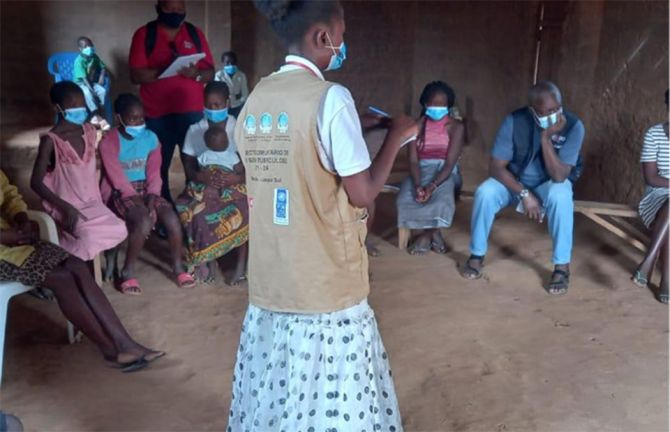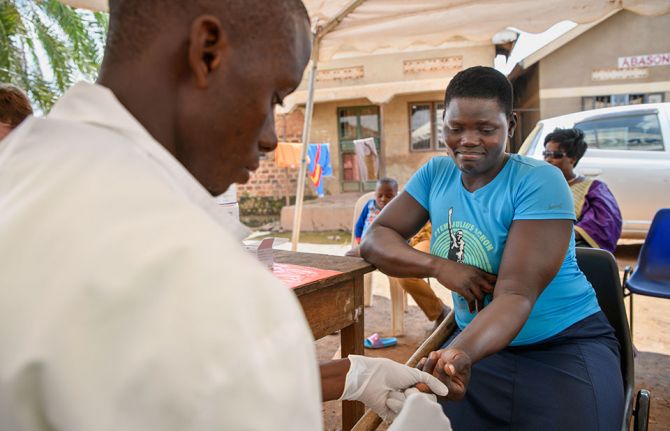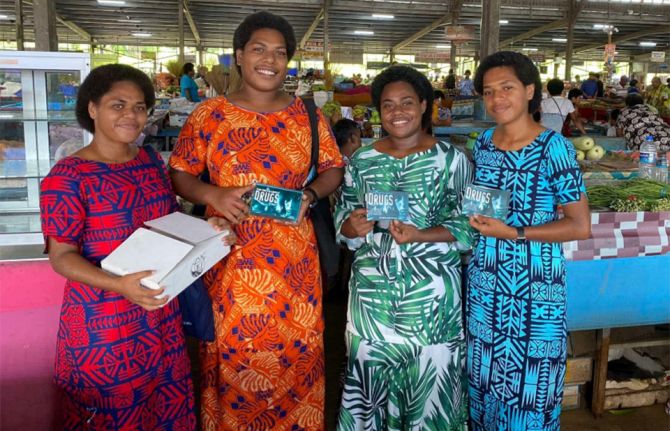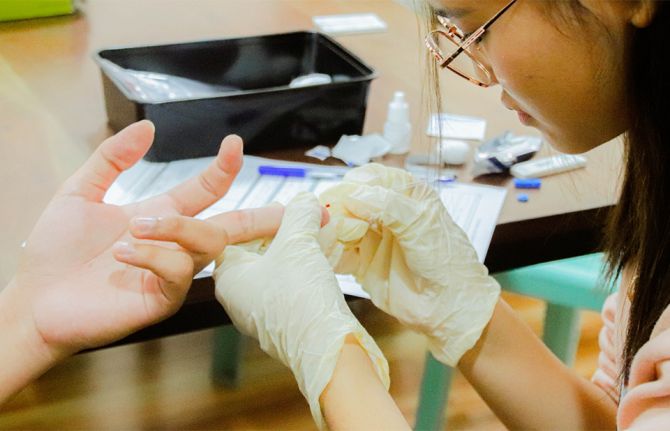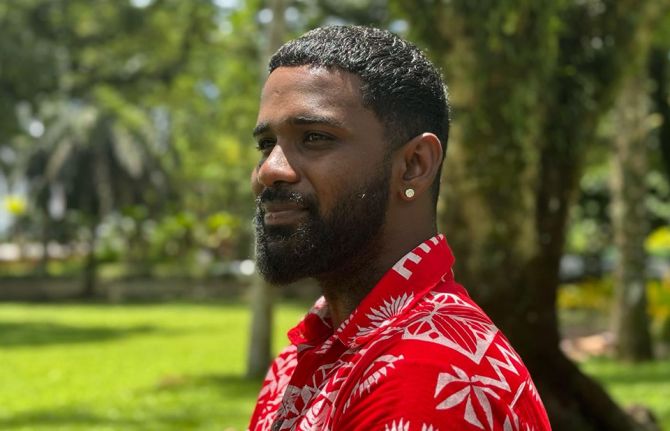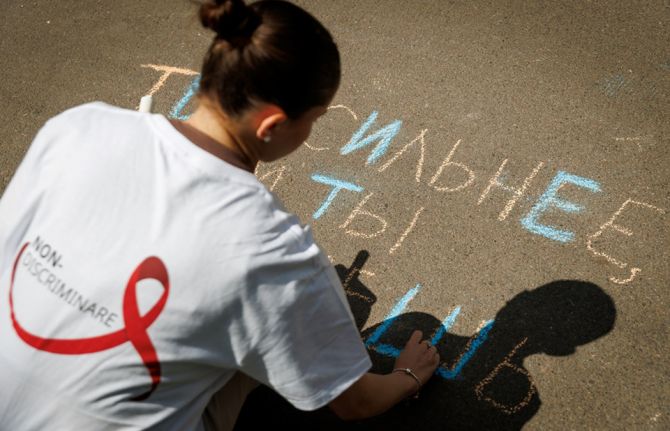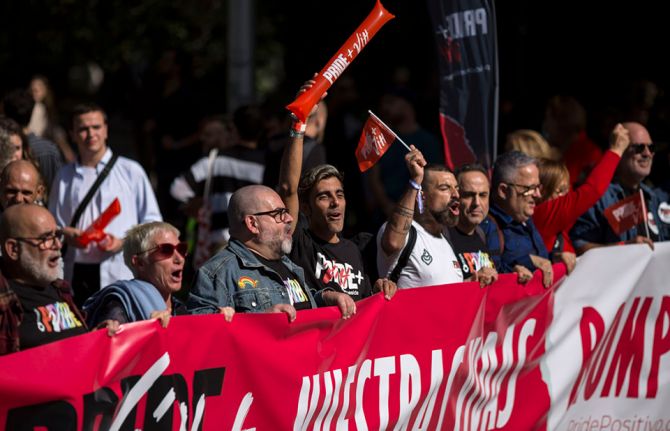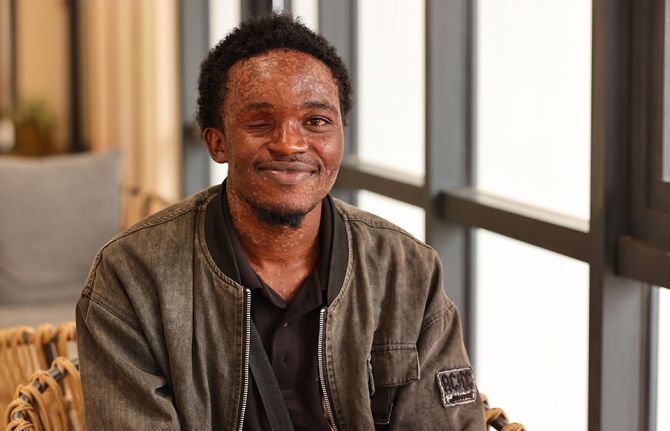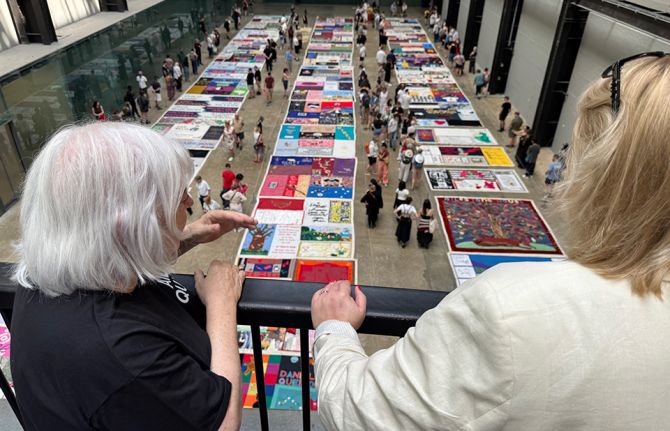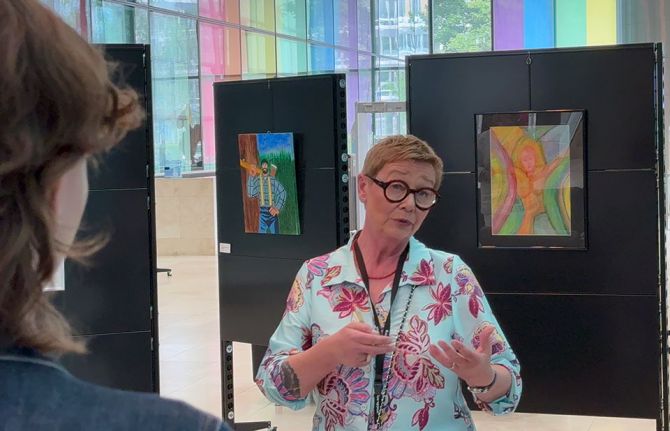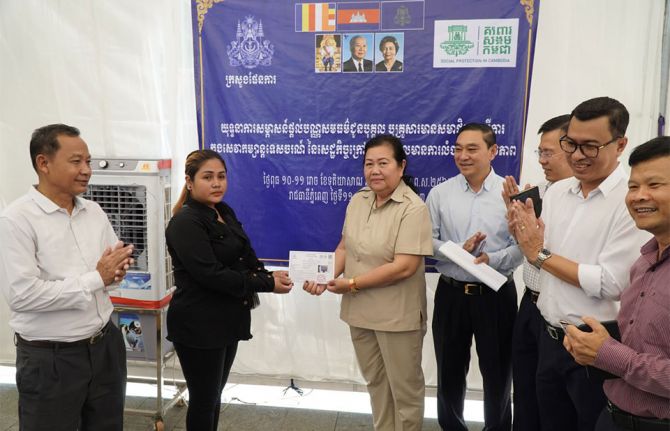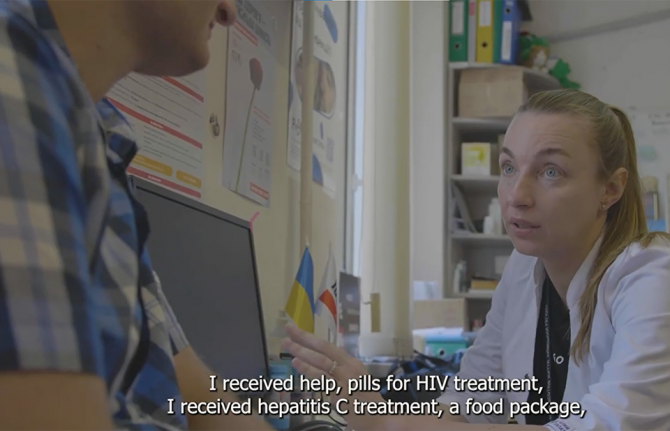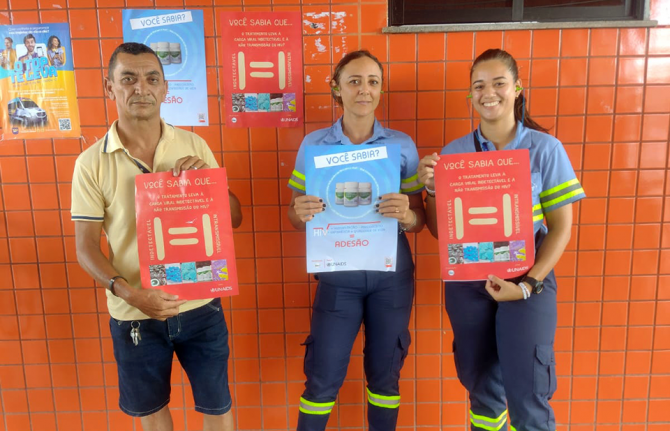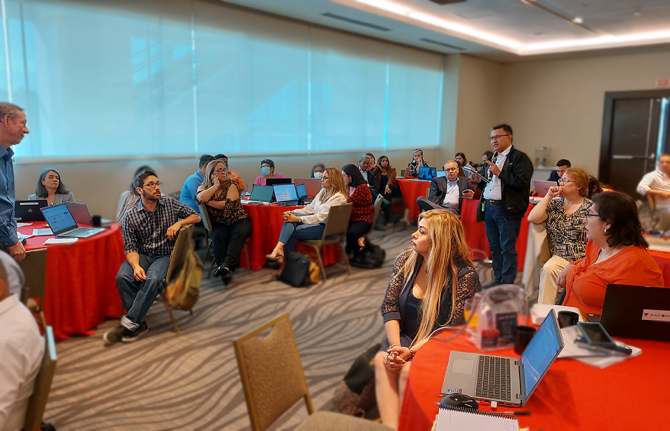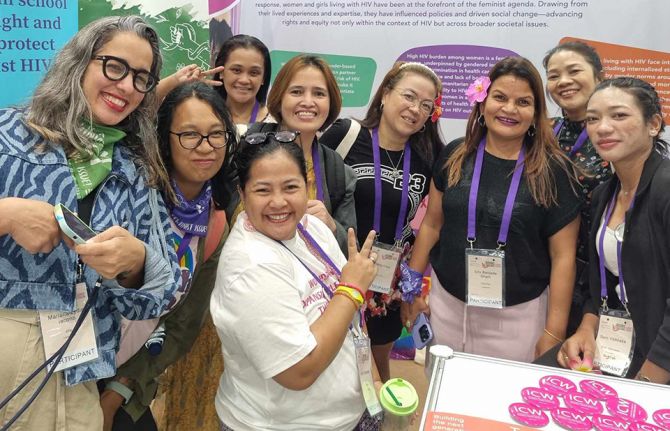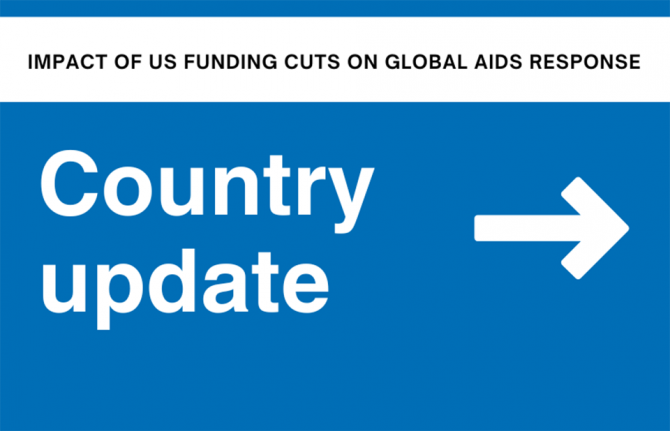
Feature Story
New policy brief on disability and HIV
08 April 2009
08 April 2009 08 April 2009
The new policy brief explores the links between HIV and disability and makes recommendations for policy change.
Credit: WHO/Asis Senyal
An estimated 650 million people, or 10% of the world’s population, have a disability. Although people with disabilities are found within the populations at higher risk of exposure to HIV, not much attention has been paid to the relationship between HIV and disability.
For this reason, the Joint United Nations Programme on HIV/AIDS (UNAIDS), the World Health Organization (WHO) and the United Nations Office of the High Commissioner for Human Rights (UNOHCHR) have collaborated on a policy brief that explores the links between HIV and disability and makes recommendations for policy change.
This policy brief discusses the actions needed to increase the participation of persons with disabilities in the HIV response and ensure they have access to HIV services which are both tailored to their diverse needs and equal to the services available to others in the community.
Evidence shows that people with disabilities are at the same or greater risk of HIV infection as non-disabled people. Due to insufficient access to appropriate HIV prevention and support services, persons with disabilities may engage in behaviours which place them at risk of HIV infection, such as unprotected heterosexual or male-to-male sex (including in the context of sex work) and injecting drug use.
The policy brief states that a large percentage of persons with disabilities experience sexual assault or abuse during their lifetime, with women and girls, persons with intellectual impairments and those in specialized institutions, schools or hospitals being at particularly high risk. There is also evidence that in some cultures, persons with disabilities are raped in the belief that this will “cure” an HIV-positive individual.
Persons with disabilities may not benefit fully from HIV and related sexual and reproductive health services because services offered at clinics, hospitals and in other locations may be physically inaccessible, lack sign language facilities or fail to provide information in alternative formats such as Braille, audio or plain language. Also, service providers may lack knowledge about disability issues, or have misinformed or stigmatizing attitudes towards persons with disabilities.
As stated in the 2006 Convention on the Rights of Persons with Disabilities, persons with disabilities have the right to participate in decisions which affect their lives, and should be fully involved in the design, implementation and evaluation of HIV policies and programmes. This is the best way of ensuring these policies and programmes are responsive to their needs.
The policy brief on Disability and HIV calls for HIV services to be inclusive of persons with disabilities. It makes recommendations to governments, civil society and international agencies to eliminate physical, information and communication, economic and attitudinal barriers not only to increases access to HIV programmes, but to assist people in accessing broader health and social services.
Right HAnd Content
Cosponsors:
Feature stories:
Disability and HIV in Jamaica (08 September 2008)
Publications:
Policy brief: Disability and HIV (pdf, 207 Kb)
Related
 Towards a life of dignity for people living with disabilities
Towards a life of dignity for people living with disabilities

15 February 2022

Feature Story
UNAIDS Committee of Cosponsoring Organizations meet
06 April 2009
06 April 2009 06 April 2009
(from left): Joy Phumaphi, Vice President and Head of the Human Development Network, World Bank; Arnauld Akodjenou, Director, Division of Operational Services, UNHCR; Josette Sheeran, Executive Director, WFP; Anarfi Asamoa-Baah, Deputy Director General, WHO; Assane Diop, Executive Director, Social Protection Sector, ILO; Koichiro Matsuura, Director General, UNESCO; Ad Melkert, Administrator ad-interim, UNDP; Ann M. Veneman, Executive Director, UNICEF; Michel Sidibé, Executive Director, UNAIDS; Thoraya Ahmed Obaid, Executive Director, UNFPA; Antonio Maria Costa, Executive Director, UNODC. Paris, 3 April 2009,
The Joint United Nations Programme on HIV/AIDS (UNAIDS) brings together the efforts and resources of ten UN system organizations in the AIDS response. The UNAIDS Committee of Cosponsoring Organizations (CCO) serves as the forum for these Cosponsors to meet on a regular basis to consider matters of major importance to UNAIDS, and to provide input from the Cosponsoring organizations into the policies and strategies of UNAIDS.
On 3 April 2009, the CCO held their first meeting since the appointment of UNAIDS Executive Director Michel Sidibé.
The CCO expressed their full support for “universal access” which Mr Sidibé has outlined as the top priority for UNAIDS as well as the other priority areas of focus which will be set out in the new UNAIDS outcome framework currently being finalized with Cosponsors.
The meeting provided an excellent opportunity to share ideas on supporting countries in achieving their universal access goals. The need for UNAIDS to advocate for an evidence informed AIDS response that is grounded in human rights was accepted by all. Equally important was the need for accountability and results.
The CCO also endorsed the general directions of the 2010-2011 Unified Budget and Workplan including the key priorities and the allocation of resources between the Cosponsors, the Secretariat and Interagency activities. The Secretariat will now work with the Global Coordinators of the Cosponsors to finalize the UBW for the June 2009 meeting of the Programme Coordinating Board.
UNAIDS Committee of Cosponsoring Organizations (CCO)
The CCO comprises representatives from the ten UNAIDS Cosponsors and the UNAIDS Secretariat. It meets twice a year and each Cosponsor rotates as chair of the committee annually, on 1 July.
Right Hand Side
Cosponsors:
Office of the United Nations High Commissioner for Refugees (UNHCR)
United Nations Children's Fund (UNICEF)
World Food Programme (WFP)
United Nations Development Programme (UNDP)
United Nations Population Fund (UNFPA)
United Nations Office on Drugs and Crime (UNODC)
International Labour Organization (ILO)
United Nations Educational, Scientific and Cultural Organization (UNESCO)
World Health Organization (WHO)
World Bank
Related
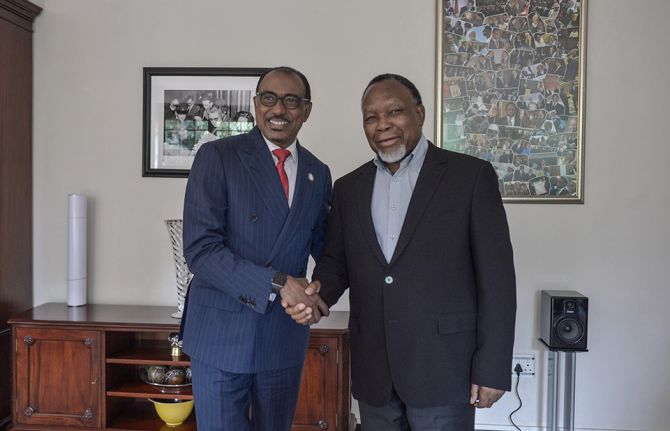 Keeping up the momentum in the global AIDS response
Keeping up the momentum in the global AIDS response

24 April 2019
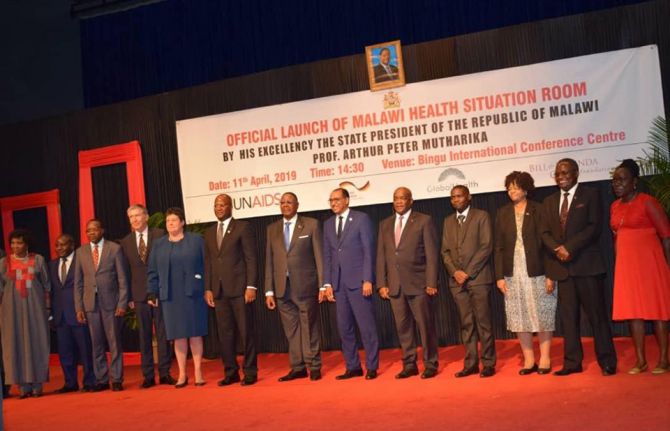 Malawi launches its health situation room
Malawi launches its health situation room

12 April 2019
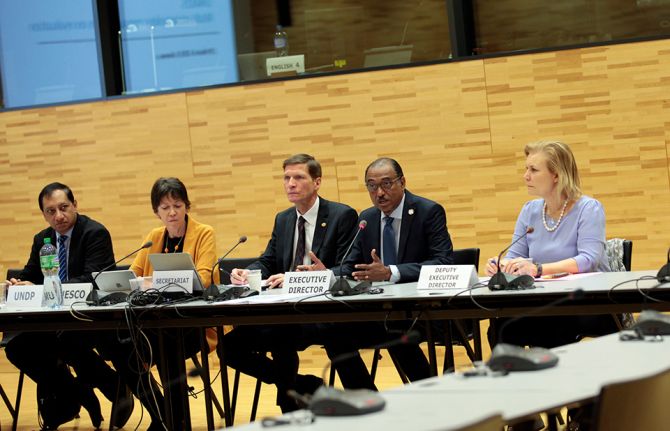 Learning lessons on evaluation
Learning lessons on evaluation

02 April 2019

Feature Story
‘Love and Relationships’: Film festival in Cambodia addresses HIV prevention
06 April 2009
06 April 2009 06 April 2009A version of this story was first published on UNESCO.org

‘The cinema road’ crosses Cambodian provinces. Credit: CCF
Last month audiences in selected Cambodian provinces had the chance to see the Khmer film Palace of Dreams as part of the ‘Love and Relationships’ film festival sponsored by UNESCO in cooperation with the French Cultural Centre (CCF). This drama, produced in 2008 by BBC World Service Trust, aims at reducing the risk of HIV infection transmission among young people.
Palace of Dreams is a powerful 90 minute feature about young people and their relationships. It aims to entertain and encourage the target audience to adopt behaviours that will reduce their risk of HIV infection and transmission. The drama was screened in 11 Cambodian provinces by the end of March.
Although HIV rates are on the decline in Cambodia, there is no room for complacency, especially for young people, as infection rates are highest among under 24-year-olds. Some specific groups are especially in need of HIV prevention information and are a particular focus within the film:
- out-of-school youth, including the 47% that work for a living, often far from home;
- young people in a relationship who say they trust their partner and do not use condoms;
- female entertainment workers;
- men who have sex with men, who have an HIV prevalence of 5.1%, which is more than five times higher than the national average.
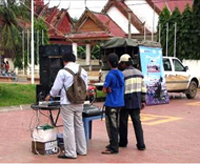
Installation of the equipment for the evening screening. Credit: UNESCO
Since March 2008 ‘The Cinema Road’ project (La Route du Cinema), organized by the French Cultural Centre, has shown, free of charge, several movies in 15 different provinces of Cambodia and has reached more than 30,000 viewers.
In November 2008 UNESCO’s office in Phnom Penh joined CCF in the ‘Love and Relationships’ programme, which aims to reach the maximum number of people in Cambodia and highlights challenges that the young face in intimate relationships. It focuses particularly on HIV prevention, sexuality and discrimination based on gender and/or sexual orientation; topics that formal education has been reluctant to address explicitly.
For this joint project, CCF selects French films (mostly comedies) translated into Khmer while UNESCO chooses films related to the above-mentioned subjects. Each month one movie from CCF and one from UNESCO are screened in a selected province.

Entire families attend an open-air screening. Credit: UNESCO
The screenings follow a set pattern. The CCF projectionist arrives in the province at noon and tours the town, announcing the event and inviting people to attend the show in the evening. A local NGO, responsible for distribution, organizes a prior sensitisation of the public and technical arrangements are made with the help of local people.
Entire families and groups of friends attend the open-air screening, which takes place in a workshop environment, accompanied by a facilitated discussion. When the film is finished the projectionist takes his camera and interviews young people from the audience, asking them questions related to the drama.
The project has been very well received by the public. The two movies that have drawn the greatest positive reaction are Palace of Dreams, being screened currently, and In the Dark, shown in November 2008.
Right Side Content
Cosponsors:
Partners:
French Cultural Centre, Cambodia (Centre Culturel Francais, Cambodge)
BBC World Service Trust
Feature stories:
Love in a Time of HIV (19 December 2008)
Powerful film brings AIDS issues to communities in Democratic Republic of Congo (16 June 2008)
Multimedia:
Publications:
Art for AIDS (pdf, 2.12 Mb)
UNAIDS Expert Consultation on Behaviour Change (pdf, 1.29 Mb)

Feature Story
Call for global action on the threat of drug-resistant tuberculosis
03 April 2009
03 April 2009 03 April 2009
Dr. Bernhard Schwartländer, UNAIDS Country Director for China, chaired a session on TB/HIV at the meeting.
Ministers from the 27 countries with the highest burden of multi-drug resistant and extensively drug-resistant tuberculosis (M/XDR-TB) have jointly endorsed a Call for Action on TB control and care to urgently address this alarming threat. The meeting in Beijing, China, on 1-3 April 2009, was organized by the World Health Organization (WHO), the Ministry of Health of the People's Republic of China and the Bill & Melinda Gates Foundation.
The two main aims of the meeting were to build consensus and political commitment globally and in countries with high levels of M/XDR-TB, and to act immediately to scale up the prevention and management of drug resistant tuberculosis. This will include developing five year national strategic plans, embedded within national TB and health sector plans.
The Call for Action, endorsed on the first day, recognizes the serious threat that this type of TB poses to people living with HIV and draws attention to the actions required to scale-up M/XDR-TB prevention, control and care. Countries are asked to identify the groups most vulnerable to, and at risk of, drug resistant TB and its impact, including people living with the virus, drug users, prisoners, migrant populations and other marginalized groups and to ensure that services to prevent and treat M/XDR-TB are targeted to meet their needs.
Among the recommendations was a call for governments and partners to strengthen efforts to mobilize more funding to finance care and control of the diseases and increase investments in the research and development of new TB diagnostics, medicines and vaccines effective in people living with HIV.
Drug resistant TB and HIV
The 33 million people living with HIV around the world are especially vulnerable to the impact of M/XDR-TB, a drug-resistant form of tuberculosis. They are at increased risk of contracting such types of TB and experiencing serious side effects and drug interactions when second-line drugs are taken with antiretroviral therapy. They are also at much higher risk of dying if affected by M/XDR-TB.
During a session chaired by UNAIDS Country Director for China, Dr Bernhard Schwartländer, the meeting discussed in detail how to strengthen TB/HIV collaboration. Participants agreed that the HIV community has to take greater responsibility for preventing, diagnosing and treating TB among people living with HIV. Michel Sidibe, Executive Director of UNAIDS, has recently stressed UNAIDS commitment and has made ‘stopping people living with HIV from dying of TB’ an organizational priority.
In line with this, Dr Brad Hersh of the WHO HIV/AIDS department stressed the need for TB and HIV programmes to work more closely together to gain efficiencies in these times of economic crisis. Better TB/HIV collaboration has the additional advantage of helping to overcome common health system barriers to successful programme implementation such as laboratory strengthening, quality assured drug supplies, and monitoring and evaluation.
Cindy Kelemi from the Botswana Network on Ethics, Law and HIV/AIDS (BONELA) urged participants to ensure that investment in HIV prevention, treatment and care was not cut as a result of the economic downturn as this would worsen the epidemic of drug resistant TB.
Affected communities are a highly valuable resource in the response and should be engaged in the planning, implementation and monitoring of activities to control and treat M/XDR-TB. Such a participatory approach is also critical in addressing the rising stigma and discrimination around TB, and to further protect the human rights of individuals affected by the disease. This need for community involvement and inclusion of people affected by TB was highlighted by South Africa’s Minister of Health, Ms Barbara Hogan.
More information about the meeting and the Call for Action can be accessed at http://www.who.int/tb_beijingmeeting/en/index.html
Note: Multi-drug resistant TB (MDR-TB) is tuberculosis that is resistant to at least Rifampicin and Isoniazid, the two most powerful anti-tuberculosis drugs. Extensively drug- resistant TB (XDR-TB) is MDR-TB that is also resistant to at least two out of the three classes of second line TB medicines.
Right Side Content
Cosponsors:
Partners:
Bill and Melinda Gates Foundation
Stop TB Partnership
Botswana Network on Ethics, Law and HIV/AIDS (BONELA)
Feature stories:
Call for fully funded Global Fund to fight AIDS, Tuberculosis and Malaria (31 March 2009)
UNAIDS Executive Director meets with TB Programme Managers, TB civil society (26 March 2009)
Need for scale up in integrated TB and HIV screening to address linked epidemics (24 March 2009)
ICASA 2008: Collaborative TB and HIV activities essential (03 December 2008)
World Lung Health experts discuss TB and HIV (15 October 2008)
TB deaths rise in people living with HIV (17 March 2008)
MDR-TB more common in people living with HIV (28 February 2008)
Publications:

Feature Story
El Salvador: Ministerial decree to reduce homophobia in health services
03 April 2009
03 April 2009 03 April 2009 Dr. Guillermo Maza, Minister of Health of El Salvador signing the ministerial decree on 5th March 2009.
Dr. Guillermo Maza, Minister of Health of El Salvador signing the ministerial decree on 5th March 2009.The Ministry of Public Health and Social Assistance of El Salvador approved, as part of its National Plan on HIV prevention, a set of actions to reduce homophobia and any type of discrimination based on sexual orientation in the health services.
In its 2008 country progress report El Salvador identified human rights violations as a major barrier to an effective response to the AIDS epidemic. The ministerial decree signed on 5th March 2009 by the Minister of Health Dr. Guillermo Maza, guarantees access to health services and respect of human rights to men who have sex with men, transgender, transvestites and lesbians.
The ministerial order states that all public health services such as hospitals, health clinics, etc. and their staff must facilitate, promote and support actions to eradicate discrimination based on sexual orientation. The decree also calls for all health institutions in the country to report back on the actions taken to reduce homophobia and discrimination.
This ministerial decree reflects the fundamental principle of respect for the human rights of all those who suffer from stigma and discrimination and it reaffirms the spirit of the universal access to HIV prevention, treatment, care and support under a human rights frame.
César Antonio Nuñez, UNAIDS Director Regional Support Team for Latin America
“This ministerial decree reflects the fundamental principle of respect for the human rights of all those who suffer from stigma and discrimination and it reaffirms the spirit of the universal access to HIV prevention, treatment, care and support under a human rights frame,” said César Antonio Nuñez UNAIDS Director Regional Support Team for Latin America.
The decree also encourages multilateral cooperation agencies and International financing institutions to provide funds and technical support directed to effectively respond against discrimination.
According to UNAIDS, El Salvador has an HIV prevalence rate of 17.8% amongst men who have sex with men (MSM).
Aside from the individual pain homophobic attitudes inflict, the continuing stigma attached to same-sex relations is complicating the task of slowing the spread of HIV in the Latin America region in general where sex between men is a leading mode of HIV transmission according to national reports. Stigma and homophobia increase the isolation of gays, bisexuals and transgender people making them more reluctant to come forward, get advice and access HIV services such as treatment, testing and counseling.
By signing the ministerial decree, El Salvador builds on the country’s commitment to seriously expand efforts to address stigma and discrimination in health settings which will facilitate the intake of HIV services by one of the key populations at higher risk of HIV infection
Right Side Content
Feature stories:
The President of El Salvador meets with UNAIDS Executive Director (11 June 2008)
Lions Club International signs Central America agreement with UNAIDS and UNICEF (10 March 2008)
External links:
Ministry of Health of El Salvador (in Spanish)

Feature Story
In memory of Lynde Francis: HIV activist and beacon of hope
03 April 2009
03 April 2009 03 April 2009By Sophie Dilmitis,
World YWCA, HIV and AIDS Coordinator
and International Community of Women Living with HIV and AIDS (ICW) European Regional Representative.
Lynde Francis (8 November 1947 - 31 March 2009)
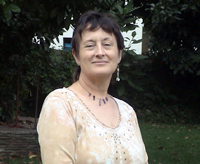
Lynde Francis (8 November 1947- 31 March 2009). Lynde’s achievements, especially in HIV and AIDS are too many too mention in this article – what she managed to achieve in a lifetime – some never do in ten lifetimes.
There are some people who leave a mark on you after you have met them and there are some people whose words you hang on to and whose advice you cherish. Lynde was one such person, not only to me but also to many people around the world.
Lynde was one of the first women in Zimbabwe to disclose her HIV-positive status and did this to support the people of Zimbabwe. She started an organization called the Centre in her own living room at home and this grew into community based organization that supported thousands of people and was run by and for people living with HIV. The centre and the work she did nationally, regionally and internationally have become her legacy.
Lynde will be remembered and respected around the world for her advocacy and education efforts on all aspects of holistic management of HIV, as well as an advocate for the meaningful involvement of People Living with HIV (MIPA). Lynde was also the Southern African Regional Representative for the International Community of Women living with HIV (ICW) and a founding member of the Pan African Treatment Activists movement (PATAM). She served on the boards of Women and AIDS Support Network (WASN), Cedas Trust, Zimbabwe Activists on HIV and AIDS (ZAHA) and was a member of the regional reference group for the ecumenical HIV and AIDS initiative in Africa (EHEIA). Lynde was part of the Country Coordinating mechanism for Zimbabwe and a founding member of the Zimbabwe National Network of People Living with HIV.
Lynde’s achievements, especially in HIV and AIDS are too many too mention in this article – what she managed to achieve in a lifetime – some never do in ten lifetimes.
Lynde had some wonderful qualities and in so many ways Lynde was a pioneer. She was a great listener and a healer, a brave advocate, an inspirational teacher, a friend and a mother to so many of us who were diagnosed HIV positive.
It is with unforgettable gratitude that I reflect and remember on how available she was to me and I wondered if she was like this with everyone that she worked with. The more I saw of Lynde the more I realised that she was like this with everyone and always gave so much of herself. With everything she had going on she really cared about people and I knew Lynde would always be there for me.
Sophie Dilmitis, World YWCA, HIV and AIDS Coordinator and ICW European Regional Representative.
I met Lynde over ten years ago at the age of 22. I had just been diagnosed HIV positive and my doctor had very little information on HIV. Life felt overwhelming and it was Lynde that explained to me what HIV was, how it worked and how I could look after my body. Lynde nurtured and invested in me so that I am fortunate enough to be in the position that I am in today. Ten years ago HIV treatment (ARVs) were not that accessible in Zimbabwe and totally unaffordable to almost all. I was confused and was trying to process many different opinions about what I should be doing. It was Lynde’s calm voice that resonated with me in my decisions about how to deal with my life with HIV. It was Lynde that took the time to deal with the rage that consumed me and she did this whilst working with so many others, running an organization and leading national campaigns.
It is with unforgettable gratitude that I reflect and remember on how available she was to me and I wondered if she was like this with everyone that she worked with. The more I saw of Lynde the more I realised that she was like this with everyone and always gave so much of herself. With everything she had going on she really cared about people and I knew Lynde would always be there for me.
I learnt many things from Lynde and would like to share the following with you:
- You life is your responsibility – Lynde once told me and many others, that she had a little box of tricks that she could have used to end her life. She had created it when she first found out she was positive but she had such a passion for life that it was only ever used a reminder to her that life is worth fighting for and taught many people how to fight for their own lives and to take responsibility for their lives.
- Lynde had the greatest respect for people and their culture. She had an incredible ability to empathise with people and put herself in their shoes, no matter how uncomfortable this may have been sometimes. Lynde taught me that it is important to meet people where they are mentally, emotionally and culturally instead of pushing them to meet you.
- As activists we don’t have to be at every meeting in the world. The world won’t collapse without us. Things do carry on and we can’t be everywhere and do everything. Some people living with HIV have a sense of urgency and this was something that Lynde herself struggled with.
Lynde lived a full life and it is so clear that many people deeply loved Lynde and celebrate all that she was and did. Like some of us, Lynde may have been afraid sometimes but in all the time that I knew her, I never saw her back away from a challenge. She was open and available to all who needed her and she had a heart of gold.
Lynde we will all miss you. You were so much to all of us and all we can do now is hold onto the memory of your great and powerful spirit and ensure that you live on in all of us whose lives you transformed. We celebrate your life and all that you gave.
Lynde celebrated 23 years of living with HIV in March this year. She leaves behind a huge family around the world that includes ten grandchildren. We extend our sincere condolences to Lynde’s family and friends. We cry with you as we appreciate her life of service to women and men, especially those living with HIV and her unwavering commitment to young people.
Lynde will remain a beacon of hope for all of us.
Related

Feature Story
HIV and high food prices
01 April 2009
01 April 2009 01 April 2009Leaders of the Group of Twenty (G-20) countries are gathering in London for a summit to identify steps that can help restore global economic growth.
The current crisis in financial markets and the world economy strains both governments’ global development commitments and national resources. Households already most vulnerable to poverty, risk further impoverishment.
This is the first in a series of articles on how poverty impacts people already affected by HIV and how investment in sustainable financing is critical for AIDS and development responses around the world. Access to affordable food is vital for workers living with HIV, explains Robin Landis, HIV Policy Officer with the World Food Programme.
HIV and high food prices
This article appears in the current edition of AGENDA magazine, published by the International Transport Workers’ Federation.

A truck driver in Mali. Credit: UNAIDS/P. Virot
Although antiretroviral drugs (ARVs) are free in Mozambique and access to them is relatively easy, Ana Costa abandoned her treatment some months ago after two years of suffering from nausea and weakness as a result of taking the powerful drugs on an empty stomach. Ana is not alone in facing a gut-wrenching dilemma – her health is so fragile that she is unable to work yet if she does not work she cannot afford to buy food. Although she knows that her health depends on the ARVs, she feels that she has no choice but to abandon the treatment since she cannot eat regularly.
It may not be the first thing one thinks of when the topic of HIV comes up, but food and more precisely, good nutritious food, is often the most pressing need for people living with HIV and their families. Malnutrition and HIV are a deadly combination: HIV attacks the immune system and deteriorates the nutritional status one needs to fend off infections while poor nutritional status hastens the onset of AIDS-related illnesses.
Hunger plays a commanding role in spreading the virus, as it drives people to desperate measures that put their lives and others at risk just to put food on the table.
Hunger plays a commanding role in spreading the virus, as it drives people to desperate measures that put their lives and others at risk just to put food on the table. In parts of southern Africa it is not uncommon for women to be forced into exchanging sex for a meal, a ride to the clinic or school fees for their children. The immediate need to make ends meet can cloud the decisions that impact their long-term future.
The importance of good nutrition for healthy living is well established and it is equally well known that mobile transport workers have less than optimum nutrition due to the demands of the job. It is common for transporters to eat irregular meals of poor nutritional quality for extended periods while they are working. Poor nutrition has a direct impact on the body’s ability to fight off infection and remain strong and productive on the job.
High food prices make a bad situation worse
The impact of climate change and the loss of agricultural land due to biofuel production have both contributed to inflated food and oil prices, which in turn have seriously impacted food production and distribution costs. The current crisis is affecting people around the world, especially those living in developing countries – people in rural areas who depend on agriculture for their livelihood and urban dwellers who must purchase everything they eat.
The sharp rise in global food prices, especially since early 2008, has already resulted in dietary changes that severely affect the health and nutritional status of millions of people. To cope with this crisis many families will avoid more expensive foods that also happen to be the most nutritious (meat, poultry, eggs and fish, fruit and vegetables) and reduce the size and frequency of meals.
Such dramatic changes in food consumption can have dire nutritional and health consequences for the most vulnerable in society: young children, pregnant and lactating women and the chronically ill, especially those with TB, HIV and AIDS. For poor, HIV-affected households the shift to less nutritional foods may happen sooner as a result of the increased burden of care. When the quality of food goes down so does the presence of micronutrients, which in turn can trigger illness and infections, making the already sick even sicker. It can also lead to drug resistance, treatment failure and even new strains of virus as HIV-positive people begin to skip doses or abandon treatment altogether because they have no food to accompany their medication.
The same goes for people on TB treatment. They are at increased risk of dropping out of treatment programmes as they divert money that would be spent on transportation or other needs in favour of buying food. Interrupted TB treatment can result in the proliferation of multi-drug resistant and extremely drug resistant strains of TB – both of which jeopardise the wider public health.
What does this mean for transport workers?
Mobility is a driver of the HIV epidemic. But there are other lesser-known links between the transport sector, HIV incidence and high food prices. In southern Africa, where HIV prevalence is the highest, AIDS has affected transport companies to the point that, even before we see the full impact of this current crisis, there are not enough truck drivers to meet demand. For instance, during the food crisis of 2003-05, the World Food Programme (WFP) contracted over 30 per cent of the total transport business in the region and found it difficult to hire enough vehicles and drivers to deliver food assistance quickly and efficiently. Approximately 80 per cent of WFP’s transport needs are hired locally. The shortage of skilled drivers results in higher transport costs and subsequent higher prices for food and other goods.
WFP is proud to be a core partner, along with TNT, ITF and UNAIDS, of the North Star Foundation, a public-private partnership to improve the health and wellbeing of mobile transport workers and reduce the number of new HIV infections by establishing networks of roadside ‘wellness centres’.
Food aid for HIV
WFP estimates that 22 of the 30 countries in greatest need of food assistance are in sub-Saharan Africa, home to two thirds of the 33 million people living with HIV. In the past, only the poorest 10 per cent of the population has generally needed assistance, but as prices increase more households will slide into poverty and be forced to find ways to cope. Women, who already represent 70 per cent of the world’s poor, will suffer the most as more will be pushed into transactional sex to survive, which increases the risk of new infections.
Providing HIV positive people with a way out of poverty can help ensure that they have nutritious food on the table, an education for their children and access to medical care and treatment. With food prices projected to stay high, incorporating a nutritious food package into HIV treatment programmes can maximise the benefits of the medicine and guard against treatment failure. For as little as US$0.70 an adult living with HIV can receive a nutritious ration of corn-soya blend, maize meal and beans. In addition to food aid, programmes that link households to livelihood support programmes are needed. If markets are able to provide a nutritious diet, cash transfers or micro-financing may be more appropriate than food packages.
What can workers’ unions do?
- Advocate national policies that prioritise HIV and TB treatment programmes and incorporate nutritional packages as part of these programmes.
- Use national and regional meetings to inform and educate union members on issues of food and nutrition insecurity in the context of HIV and AIDS.
- Be the eyes and ears of the community: let the ministries of health and national AIDS committees know when communities are struggling with the decision to either spend on health care or buy food.
- Support workplace HIV programmes and make sure that they address the importance of good nutrition for people living with HIV. Work with the programme manager to offer advice and assistance to HIV-positive employees who may be having difficulty keeping a healthy diet.
- Use union networks to help distribute agricultural inputs like fertilizer, seeds and tools and help link communities to markets.
- Lobby employers to ensure that nutrition information and access to nutritious food is available for mobile transport workers while on the job.
Robin Landis is a Policy Officer in the Policy, Planning and Strategy Division of the WFP in Rome. She is also on the Management Team of the North Star Foundation, a public-private partnership to reduce the impact of HIV in the transport sector.
Right Side Content
Cosponsors:
Partners:
Feature stories:
Minister of Foreign Affairs of the Russian Federation discusses financial crisis with UN agencies (09 March 2009)
As global economy slows International Health Partners push for faster health progress (12 February 2009)
The impact of nutrition and HIV: World Food Programme (26 November 2008)
External links:
Agenda Magazine, Issue 3, 2009 (pdf, 1.49 Mb)
Related

Feature Story
New UNGASS Guidelines for 2010 reporting
31 March 2009
31 March 2009 31 March 2009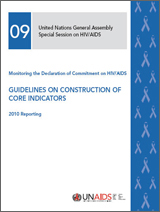
UNGASS Guidelines on Construction of Core Indicators for 2010 reporting.
To assist Member States in preparing and submitting their 2010 Country Progress reports, UNAIDS has released the new UNGASS Guidelines on Construction of Core Indicators for 2010 reporting.
In adopting the 2001 Declaration of Commitment on HIV/AIDS, Member States committed themselves to regularly report to the United Nations General Assembly on the progress made in their country’s response to the AIDS epidemic. The UN Secretary-General assigned the UNAIDS Secretariat the responsibility of developing the reporting process, accepting reports from Member States on his behalf, and preparing a regular report for the General Assembly. Member States submit Country Progress reports to the UNAIDS Secretariat every two years.
The new guidelines provide essential information on the composition of core indicators for reporting including the purpose of the indicator, methods of measurement and a summary interpretation of the indicator. The guidelines are also intended to ensure consistency of information across countries for accurate global progress analysis.
At country level, the progress reports are used to inform programmatic decisions, review national strategic plans and to inform resource mobilization efforts such as the development of proposals for the Global Fund. Furthermore, the country reports have also helped countries identify their gaps and weaknesses regarding data monitoring and evaluation. Country reports also enable open discussion and assessment of progress between the governments, civil society and other key stakeholders engaged in the national AIDS responses.
The data submitted in the next round of reports will be used by UNAIDS to monitor the progress made by countries towards achieving universal access to HIV prevention, treatment and care in 2010 and eventually in reaching the Millennium Development Goal of arresting and halting the spread of HIV by 2015. The data will also form the basis of a number of regular reports including the UN Secretary-General’s report to the General Assembly, the UNAIDS Report on the Global AIDS epidemic and the HIV section of the annual Millennium Development Goals monitoring report.
The 2010 reporting round
While there have been no changes to the UNGASS indicator set from the 2008 round, a number of changes have been made to the reporting process. Amongst these are the new reporting deadline of March 31st 2010, and the development of a system that allows on-line submission of reports through the UNGASS reporting web site. It is anticipated that these two changes will allow for more rigorous data analysis at country level prior to submission, and will streamline the cleaning and reconciliation of all data received.
The new UNGASS Guidelines on Construction of Core Indicators for 2010 reporting are now available electronically - printed copies and translations into French, Spanish and Russian will follow shortly.
Please direct all queries on UNGASS reporting to: ungassindicators@unaids.org.
Right Hand Content
Feature stories:
Much progress to report: UNGASS 2008 (12 March 2008)
UNGASS 2008: Country progress reports (04 February 2008)
Contact:
Please direct all queries on UNGASS reporting to: ungassindicators@unaids.org.
Publications:
UNGASS Guidelines on Construction of Core Indicators for 2010 reporting (pdf, 612 Kb)

Feature Story
Forum seeks to engage men and boys in goal of achieving gender equality
31 March 2009
31 March 2009 31 March 2009 (from left) Mr Michel Sidibé, UNAIDS executive director and Brazil’s Minister of Policies for Women Nilcéa Freire at the opening of Engaging Men Symposium, 30 March 2009.
(from left) Mr Michel Sidibé, UNAIDS executive director and Brazil’s Minister of Policies for Women Nilcéa Freire at the opening of Engaging Men Symposium, 30 March 2009. Credit: UNAIDS/D.Ramalho
A global symposium on engaging men and boys in achieving gender equality is taking place this week in Rio de Janeiro, Brazil. Addressing the opening ceremony last night, UNAIDS Executive Director Mr Michel Sidibé spoke of the need for all to “work over the long term to end the social acceptance of violence against women and the gender inequality that underpins it.”
“We must engage with men and boys to promote awareness of the need for a “new masculinity,” continued Mr Sidibé.
The event was opened by Brazil’s Minister of Policies for Women, Ms Nilcea Freire. Other speakers at opening ceremony included: UNIFEM Executive Director, Ms Inés Alberdi; UNFPA Deputy Executive Director, Ms Purnima Mane; Ambassador of Canada to Brazil, Mr Paul Hunt; World Health Organization Department of Gender, Women and Health, Coordinator, Peju Olukoya; and UNDP Resident Representative and UN Resident Coordinator, Ms Kim Bolduc.
Three over-arching themes of “men and violence”; “men and health”; and “men and care-giving” will be covered during the conference. Yesterday, before opening the symposium, the Executive Director of UNAIDS Michel Sidibé joined the Brazilian Minister of Women’s Policies, Ms Nilcéa Freire, in inaugurating the first centre in Brazil that focuses on rehabilitating men who abuse women. Located in Nova Iguaçu, a municipality in Rio de Janeiro, the centre will place emphasis on education programmes to put a end to domestic violence. Ten other such centres are planned for throughout the country.
Gender and HIV
We must all work over the long term to end the social acceptance of violence against women and the gender inequality that underpins it
Michel Sidibé, Executive Director, UNAIDS
Gender comprises widely held beliefs, expectations and practices within a society that define ‘masculine’ and ‘feminine’ attributes, behaviours and roles and responsibilities. Given that gender constructions are relational – one sex defined in contrast to the other, the organizers of the Rio symposium believe that men and women must both be involved in the goal of achieving gender equality. Work with men is seen as a vital component, together with, rather than apart from, work to empower women and girls.
Gender norms in many societies may dictate that women and girls are less equal than men in the home, workplace and in negotiating sex. In some societies concepts about masculinity may reinforce a belief that men should seek multiple sexual partners or take risks. These norms work against HIV prevention messages that support protection measures and fidelity. Some notions of masculinity also condone violence against women, or lead to homophobia, which results in stigmatization of men who have sex with men, making these men more likely to hide their sexual behaviour and less likely to access HIV services.
Violence and HIV
According to a 2006 report by United Nations Secretary-General at least one out of every three women around the world has been beaten, coerced into sex, or otherwise abused in her lifetime, with the abuser usually someone known to her.
In the context of HIV, men’s use of physical or sexual violence against women, or the threat of violence increases women’s vulnerability to the disease by making it difficult or impossible to negotiate safer sex and condom use. It can also stop women from accessing HIV prevention, care and treatment services. Women may also avoid HIV testing due to fears of violence and abandonment in a resulting discovery of HIV-positive status.
Moving forward
This week’s Symposium will include dialogue sessions with representatives of the women’s rights movements and other social justice movements. Skills-building workshops to build capacity of participants in designing, implementing and evaluating behaviour change advocacy and community mobilization strategies and also working with young children and teenagers in achieving gender equality.
The participants hope to develop a “Call to Action” for governments to implement policy that engages men and boys in gender equality. Engaging men and boys in achieving gender equality will combine presentations of best practices, skills building workshops, and dialogues between representatives of non-governmental organizations, policymakers, and researchers. It runs until 3 April.
Right Hand Content
Cosponsors:
Partners:
Global Coalition on Women and AIDS
UNIFEM Gender and AIDS
Speeches:
Read speech to Opening of the Global Symposium: Engaging Men and Boys in Achieving Gender Equality by Michel Sidibé, Executive Director, UNAIDS (30 March 2009)
Feature stories:
Commission on the Status of Women opens with call for action to achieve universal access and gender equality (02 March 2009)
External links:
Engaging men and boys in achieving gender equality
MenEngage

Feature Story
UNAIDS Executive Director meets with Brazilian Government and civil society
30 March 2009
30 March 2009 30 March 2009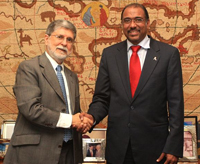
UNAIDS Executive Director Michel Sidibé (right) met with Minister of Foreign Affairs, Mr Celso Amorim.
Credit: UNAIDS/M. Silva
The upcoming Group of Twenty (G20) meeting in London, the global financial crisis, and universal access were some of the main topics Mr Michel Sidibé and Brazilian Government counterparts discussed during his first official visit to Brazil as the Executive Director of UNAIDS.
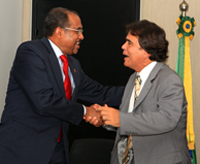
UNAIDS Executive Director Michel Sidibé (left) greets Minister of Health of Brazil, Mr José Gomes Temporão.
Credit: UNAIDS/M. Silva
Mr Sidibé met with the Minister of Foreign Affairs, Mr Celso Amorim, the Minister of Health, Mr José Gomes Temporão, the Minister of Human Rights, Mr Paulo Vanucchi, and the Minister of Women’s Affairs, Ms Nilcéa Freire.
A meeting also took place between Mr Sidibé and the HIV/AIDS Parliamentarian Group, the LGBTT (lesbian, gay, bisexual, transgender and transvestite) Citizenship Group and the Human Rights Commission. The forum which took place at the National Congress in the capital Brasilia, was an opportunity for lively exchange of ideas and viewpoints on a range of issues at the heart of Brazil’s efforts to respond to the HIV epidemic and address human rights. These issues were also underlined in meetings Mr Sidibé had with the President of the Congress and the Senate President.
Civil society share challenges and barriers in responding to diverse epidemics
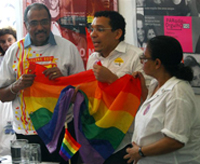
UNAIDS Executive Director Michel Sidibé meets representatives of group Arco-Iris.
Credit: UNAIDS/D. Ramalho
Two separate meetings with civil society groups in Rio de Janeiro provided Mr Sidibé an overview of the challenges facing several populations most affected by HIV, including sex workers, transgenders, gay adolescents and indigenous peoples in the Amazon region.
With ten national representatives of the Brazilian Interdisciplinary Association of AIDS (ABIA), Mr Sidibé was informed of the difficulties in responding to the many faces of Brazil’s epidemics.
HIV prevention was underscored by many representatives as an urgent issue to address, with a lack of resources to reach out to the groups most-at-risk from HIV seen as the biggest hurdle in preventing new infections.
With Grupo Arco-Íris (Rainbow Group), Mr Sidibé heard from several representatives of diverse lesbian, gay, bisexual, transgender and transvestite groups. They explained the concerns and challenges faced by them as LGBTT living in Brazil.
Grupo Arco-Íris is advocating for a change in the law in the federal senate that would make homophobic acts a criminal offence. So far, the group has collected more than 40,000 signatures in support of the law. The group also launched a HIV prevention campaign called “entre garotos” (between boys) that targets gay adolescents between the ages of 16 and 22 through tailored advertising and information displays at cafes, bars, dance halls, and other venues popular with young men who have sex with men.
Mr Sidibé pledged his continuing support to the LGBTT community and encouraged its members to mobilize and rally around efforts to achieve universal access to HIV services in Brazil.
Right Hand Content
Multimedia:
Feature stories:
Brazilian children’s society offers a home from home for children living with HIV (27 March 2009)
TB/HIV, universal access, and human rights key items on UNAIDS Executive Director’s agenda in Brazil (24 March 2009)

